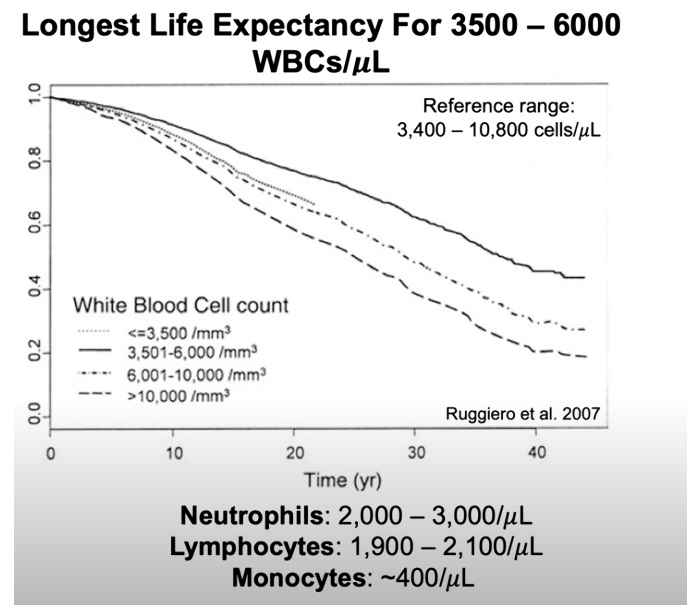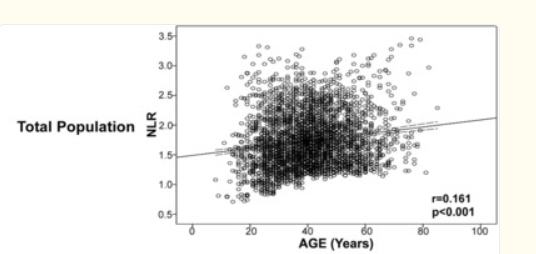The discussion of NLR in the Bryan Johnson thread caused me to look at this issue. I watched the very useful video that @RapAdmin posted a while ago about optimal levels for WBC and its components.
I looked at my own results dating back to 2014. I hadn’t paid much attention to them before, and I’m kind of irritated that my primary care doc never said anything about them (all he ever cared about was the total cholesterol number). It is obvious that I’ve suffered from some degree of inflammation for the past decade. Unclear whether or not knowing this in 2014 could have prompted action to avert the heart attack I had in 2020, but the concern now is to reduce inflammation and optimize the numbers going forward.
The Lustgarten video states that the optimal NLR is under 1.4, with the optimal neutrophil level being 2,000 to 3,000 and the optimal lymphocyte level being 1,900 to 2,100. Under 1,900 is very bad. Looking at a decade of my numbers:
-
My “most optimal” NLR scores were around 2.5, but there were some 3.3 scores and two 3.9s.
-
My neutrophils were in the 3,000 to 3,300 range - maybe a little high but “not too bad”.
-
My lymphocyte score, however, has always been dangerously low, averaging 1,100. This low denominator drives up the NLR result.
I started measuring my CRP in 2021, and those numbers have been pretty good (0.23 to 0.34). This caused me to think I was keeping inflammation in check, but looking at the NLR numbers since 2021 is causing me to doubt it.
I started taking rapa in 2022, and it doesn’t look like this has affected my neutrophil or lymphocyte levels at all.
I’ve just started looking at this, and will keep reading, but my immediate questions are:
-
Am I correct in thinking I need to raise my lymphocyte levels?
-
If so, what is the best way to do that? I am not overweight, I exercise regularly, and I don’t smoke, so no low-hanging fruit there. Specific foods or supplements?
-
How variable are these blood results? I’ve only been getting them tested once a year. Those of you who test more frequently, do your neutrophil and lymphocyte levels remain relatively stable from month to month?
-
Has anyone succeeded in using intermittent fasting to raise lymphocyte levels?
Any thoughts or suggestions much appreciated!
7 Likes
LaraPo
#2
Lymphocyte level lower than 1900 is not “very bad”. Healthy range is from 1000 to 3000. So it’s just in the middle. Your level of 1100 (still healthy level) shows that you do not have chronic infection. Also keep in mind that lymphocytes are affected by Rapamycin… Keeping it between 1000 and 3000 is considered healthy and normal by any lab.
4 Likes

Am I reading it wrong here? He argues that the hazard ratio for lymphocytes increases pretty sharply as you drop below 1,900.
3 Likes
LaraPo
#4
I bet the measurements were not done on population that takes rapamycin. I doubt that it applies the same way to those who are on rapamycin. If you want your lymphocytes increase, stop rapamycin. It happens to me all the time. When I’m on a break (from Rapa), lymphocytes increase much.
2 Likes
LukeMV
#5
Good topic for a thread. I guess Rapamycin and good lifestyle are all we know of that could improve this as of now?
@DrFraser might know more
2 Likes
Here is the general mantra on this - basically clean living, exercise, good diet …
To improve the neutrophil-to-lymphocyte ratio (NLR), which is a marker of systemic inflammation and has prognostic value in various conditions, several strategies can be considered. Lifestyle modifications such as regular exercise, stress reduction techniques like meditation or yoga, and ensuring adequate sleep can help reduce inflammation and improve immune function. An anti-inflammatory diet rich in omega-3 fatty acids, antioxidants, and fiber, while reducing processed foods and sugar intake, can also be beneficial.
Nutritional supplements like omega-3 fatty acids, vitamin D, and probiotics may help modulate immune responses and reduce inflammation. In some cases, medications such as NSAIDs, statins, or corticosteroids might be appropriate, but these should be used cautiously due to potential side effects.
Addressing underlying conditions that contribute to an elevated NLR, such as chronic infections or inflammatory diseases, is crucial. Managing chronic conditions like diabetes or autoimmune disorders can also help. Smoking cessation and maintaining a healthy weight are additional strategies to reduce systemic inflammation.
10 Likes
If anyone is smoking and taking rapamycin, I’ll start rooting for the AI takeover. Anyone care to admit it?
3 Likes
cl-user
#8
That’s a good point. How long does it take for the lymphocytes count to come back up and by what amount?
LaraPo
#9
Just a three weeks break increases it by 500 for me.
3 Likes
Smoking and Rapamycin.
There have been people who have admitted to it before. It happens.
BTW, I have never smoked.
3 Likes
My experience on this is that the Neutrophil/Lymphocyte ratio decreases with Rapamycin, which is good.
Most of my patients have total WBC’s around 2.8-3.5K. I think my last was 2.9. So yes in absolute terms your lymphocyte count will go down, but in general your neutrophil count will go down much more leading to an better ratio.
Everyone is different and I have people who do the opposite of what would be predicted, but this is the overwhelming pattern.
8 Likes
How rapidly do WBC, neutrophil, and lymphocyte levels fluctuate? I assume the immune system leaps into action pretty quickly if you get an infection. But let’s say I get a “not sick” baseline reading today - how soon do I want to re-check? Quarterly, twice a year, annually?
These can move in hours to respond to an issue. I think it is sensible when getting a CBC to get a HsCRP. If that is elevated, then there is inflammation that will drive neutrophils up, or in some cases of a viral infection lymphocytes go up. The experience with covid was we usually got a neutrophilia even though it is a viral infection.
2 Likes
Even though I quit rapa I love this forum - have never heard of this ratio. Thanks for all your input to various questions DrFraser.
4 Likes
Ulf
#15
I do all the lifestyle modifications mentioned by dr Fraser including a near-perfect diet, yet my NLR is 8 and lymphocyres abysmally low. The downhill journey probably started with extensive radiation a few years ago, but it has become even worse lately.
I have tried a number of supplements to no effect. Just started my latest effort, injecting peptide Thymosin Alpha 1
On the bright side, I have had no infection or cold or sickness for ages. All around me catch colds but not me. Could it be that the dismal numbers somehow don’t matter in my case? All my other biomarkers are fine, e.g. hsCRP 0.17, in line with my life-style. I realize this is almost certainly wishful thinking, stemming from something I read with the gist that a strong body doesn’t need a high lymphocyte count… probably bs.
3 Likes
EnrQay
#16
This study gives average lymphocytes by age in a healthy population:

with no significant difference between men and women:
other tidbits from the paper: NLR tends to go up with blood pressure, BMI, and various diseases.
4 Likes
LaraPo
#17
NLR 8 is very high. Are you sure that you are calculating the ratio correctly?
I think the main issue in terms of Rapa and NLR is that the different types of WBC have different half lives. Hence as Rapa reduces the production of new WBC it hits Neutrophils first.
You can see that in my results on this topic.
To be honest, however, although NLR is a good target for improvement, the improvement from Rapamycin is I think meaningless.
Its a bit like the reduction in MCV which generally is good, but that from inhibiting mTOR does not mean otherwise the circumstances are good.
2 Likes
Just checking on your use protocol for this one. It has a short shelf life once reconstituted. It’s recommenced that once reconstituted a vial should be used in 5 days or less.
I set up my vials for 3 to 4 doses in 5 days. Did a low dose run a couple months ago, had a small bump up in lymphocytes and we have just started a 1 month, higher dose (1.67mg per). One month = 4 vials, only reconstituted prior to use.
1 Like
Ulf
#20
It was almost 11:1 the last time before TA1. 4300 neutrophils per micrliter, 400 lymphocytes.
Maybe that was an extreme, it used to be more around 2800 and 600.
Now 2800 and 1000. Can’t wait for my order of TA1 to arrive.
1 Like